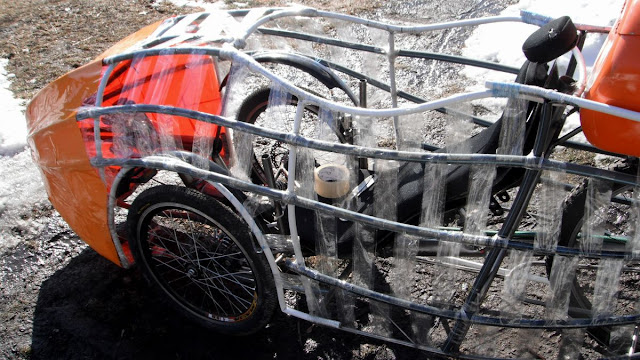The Scotchmobile: building skin on frame velomobile from a trike
Scotchmobile... all we paid money for was a scotch tape
Details:
Name Scotchmobile
Type Skin on Frame Velomobile
Year 2016
Undercarriage UNIVERSAL-2
Overall lenght 2600mm
Overall width 660mm
Overall height 1004mm
Hull height 770mm
Wheel track 590mm
Weight about 34kg
Mileage > 10000km
Weight about 34kg
Mileage > 10000km

The Scotchmobile was an intermediate research model of a velomobile based on the previous recumbent trike concept. Main purpose of the current project was gaining an experience for the further design of a velomobile. However, first we didn't plan to turn our trike into another vehicle. As a result, the size of skin on frame body was larger than it could be upon the existence of a proper frame and a special seat. Analysing the global experience of turning trikes into velomobiles we had easily figured out that such a vehicles have larger size in comparison with frameless velomobiles. The key reasons for that were a seat attachment level (higher for most trikes) and a relatively low bottom bracket. Building the frame we noticed an increase in dimensions of the section for knees caused by these 2 factors. By the way, on 3D plan the Scotchmobile was smaller.
Body:
Weight of "naked" trike was 24kg. After the attachment of panniers it was 27kg. The planned overall weight was 35kg, so we understood that for the whole velomobile body we got only 8kg left. 3D modelling allowed us to count the amount of pipes for the body carcass. It was about 30 meters of pipe. Metal-reinforced plastic pipe weight is 100g/m, so it could be 3kg of pipes only excluding the weight of fastening (represented by hundreds of screws). We decided to reduce the weigth and changed the fastening type by turning plastic bottles into roaps accodring to the popular method taken from the internet. The heat setting of the plastic roap allowed us to get a proof construction.

To increase velomobile weight reduction we used platic pipes instead of metal-reinforced plastic ones. The weight of plastic pipe equals 80 g/m that was an advantage. Besides that, the plastic pipe unlike the metal-reinforced plastic pipe is springy. Furthermore, the plastic pipe fits better for getting smooth lines along velomobile body. Nevertheless, for the low bend radius we used the metal-reinforced plastic pipe ⌀16mm.

As a skin for the velomobile we used scotch tape same time trying to reduce the overall weight. For this purpose we purchased about half a kilometer of scotch tape and 4 square meters of pressure-sensitive film. After that we made a basis mesh wrapping the pipes two-by-two in chessboard order. This allowed us not to press the body with covering and same time fasten the pipes relative to each other. Then we stuck the scotch tape along the boards covering the holes. After that we covered the body with pressure-sensitive film. Unfortunaly, 4 square meters of the film was not enough to cover the whole body of the velomobile. But as it appeared the transparent rear end was an advantage for the prototype which allowed to keep the parts visible as well as to control them. The bottom of our velomobile we spaned with tight synthetic fabric.
Other Ideas:

In addition to the skin on frame velomobile body the current project gave us a chance to implement other technical solutions often used among European constructors. For example, the hamster steering system with cardan joint. This type of steering is definitely not the best choice for an open trike (unless it's equiped with a special seat with side support) but it can be very comfortable for skin on frame velomobile. The placement of a brake handle together with 2 cables was the final idea we kindly borrowed from European school.